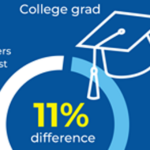Although some evidence suggests that all students, white students included, tend to benefit from studying with Teachers of Color (Bristol, 2020; Goldhaber, Theobald, & Tien, 2019), most research in this area has focused on whether Students of Color benefit from studying with teachers of the same race or ethnicity (Dee, 2004; Foster, 1997). For example, researchers have found that the presence of at least one Black teacher in kindergarten through 5th grade is related to higher test scores for Black students in reading (Easton-Brooks, Lewis, & Zhang, 2009) and mathematics (Eddy & Easton-Brooks, 2011). Likewise, the presence of Asian American teachers has been found to be related to increases in learning for Asian students in middle school math (Egalite, Kisisa, & Winters, 2015).
Studies have also found that interactions between Students of Color and Teachers of Color are related to improvements in students’ academic growth overall (Easton-Brooks, 2019; Gershenson et al., 2017); that teachers have more positive perceptions of the academic abilities of students with whom they share racial affinities (Downey & Pribesh, 2004; Easton-Brooks, 2019), and that teachers who do not share an ethnoracial affinity with Black students are more likely to punish or penalize them for classroom infractions (Lindsay & Hart, 2017).
A number of researchers have recently turned their attention also to the effects that Teachers of Color and Indigenous Teachers have on the nonacademic factors associated with student success, such as a sense of belonging, intergenerational bonding with teachers, and positive and caring student-teacher relationships. Five recent studies highlighted in the Handbook of Research in Teachers of Color and Indigenous Teachers (Gist & Bristol, forthcoming, 2022) expand the research base in this area.
What the recent research shows
Jemimah Young and Donald Easton-Brooks share a conceptual framework for analyzing the positive impact that Teachers of Color and Indigenous Teachers have on students’ sense of belonging at school, which includes influencing students’ academic, communal, and personal identities. Teachers of Color and Indigenous Teachers, they note, promote school belonging by engaging in instructional, institutional, and interpersonal practices that communicate to Students of Color that their success matters to them, while cultivating positive student-teacher and peer relationships that foster a positive sense of self-efficacy, pride, and empowerment.
A study by Natalie Holliman and Florentia Spires examines how veteran women Teachers of Color (those with 20-plus years of teaching experience) from various regions of the United States support learning for their students of color. The researchers find that these educators have two particularly valuable approaches in common: They model an ethic of warm but demanding care, and they are careful to learn about and value their students’ cultural backgrounds.
Similarly, a study by Derrick Robinson, focusing on two large urban school districts in the mid-Atlantic and southeastern regions of the U.S., finds that when Students of Color take classes with Teachers of Color, they tend to benefit from high-quality interpersonal and intergenerational connections, personalized insights into subject matter, and exposure to new perspectives on academic content. In turn, according to Students of Color, having a Teacher of Color leads to stronger self-esteem among students and a reduction in students’ internalized racism.
A case study by Chrystal Johnson and Jennifer Sdunzik examines the care-oriented pedagogies (which focus on creating healthy relationships with predominantly Black students and providing positive classroom experiences) of a Black male charter school teacher in three middle school classes over one academic year, to assess the influence of these pedagogies on students’ civic participation and racialized identities. Based on survey data from students in three classes, the researchers find that the Black male teacher positively influenced the civic and social values and behaviors of Black youth in his classes.
Finally, a study by Regina L. Suriel and Tonjua Freeman describes a duoethnography (a collaborative research method that involves studying and comparing life histories) in which they explore the impact of their practice on the science learning experiences of their predominantly white students in the Deep South. The researchers confronted students’ racist beliefs about People of Color by highlighting the contributions of People of Color in the sciences. In so doing, the researchers cultivated positive classroom relationships that supported students’ learning.
In short, a new and emerging strand of research has begun to explore the nonacademic outcomes for students who have opportunities to study with teachers of the same race/ethnicity, adding to previous research on academic outcomes. The most recent educational impact research studies differ in their methodologies, and they analyze data from differing school contexts — both urban and suburban, large and small — as well as from differing grade levels and academic subject areas. To date, however, this research has been consistent in pointing to specific benefits, including a heightened sense of belonging in the school environment, as well as stronger and more personally supportive relationships among students and teachers and fewer negative perceptions of students and their academic potential.
What we don’t know yet
While strong evidence suggests that Students of Color benefit academically from studying with teachers of the same ethnoracial background, and while emerging research has begun to explore nonacademic benefits as well, we still have much to learn about the specific contexts and conditions under which Teachers of Color might have these effects on students. For instance, we do not yet know how these benefits are related to factors such as working conditions within schools, school leaders’ commitments to racial and educational justice, or the proportion of Teachers of Color and Indigenous Teachers in a given school. Nor do we know why Students of Color benefit from studying with some Teachers of Color more than with others, nor how Teachers of Color and Indigenous Teachers influence parent engagement, professional relationships among their colleagues, or overall school culture.
Further, it would be valuable to learn more about the ways in which Teachers of Color and Indigenous Teachers influence all students, not just those with whom they share a racial affinity. Finally, researchers have only just begun to compare how teachers from various racial and cultural backgrounds may differ from one another in their effects on students and the ways in which their influence differs from that of white teachers in the same schools.
Implications for policy and practice
- School systems should provide differentiated and responsive mentoring and induction supports for Teachers of Color and Indigenous Teachers — in particular, for early-career teachers. These supports should enhance teachers’ ability to cultivate belonging and culturally sustaining practices that involve relationship building and a deep valuing of nondominant knowledge and linguistic systems.
- Explore the use of racial pairing between students and teachers when the data indicate that Students of Color and Indigenous Students are performing below level or are being disproportionately affected by disciplinary actions.
- Offer district and school leadership training on equity and diversity that highlight effective pedagogical practices of Teachers of Color and Indigenous Teachers with Students of Color and Indigenous Students.
- To increase the interest and retain a highly diverse educator workforce and student population, school districts and states should think seriously about reforming curriculums to be more inclusive to diverse populations.
- Higher education teacher prep programs and school districts should work closer on strategies to recruit and retain more diverse educators, counselors, and leaders.
- States should invest in and promote the need for a diverse educator workforce as a method to enhance educational outcomes and reduce dropout rates among all students, which in turn would have a great impact in workforce development.
Research topics to explore
- Ethnic matching between students and teachers using broader cross-sections of both Teachers and Students of Color positioned across various intersectional identities (for example, race, class, gender identity, sexual orientation, or religious affiliation).
- Mixed methods studies — those that integrate quantitative and qualitative data — focused on the educational impacts of Teachers of Color and Indigenous Teachers.
- Cross-disciplinary and grade-level analyses of the academic and nonacademic educational impact of Teachers of Color and Indigenous Teachers on their students.
- The influence of Teachers of Color and Indigenous Teachers on colleagues, school culture, and local school neighborhoods.
- Innovative methods for documenting, analyzing, and portraying the nonacademic educational impact of Teachers of Color and Indigenous Teachers.
Research studies to conduct
- Interpretive studies: Researchers can use critical, decolonial, and culturally responsive pedagogical and leadership frameworks to explore the practices of effective Teachers of Color and Indigenous Teachers on racially matched students (see Easton-Brooks, 2019). Studies of this sort would examine the subjective teaching and learning experiences of both Teachers and Students of Color in classrooms using nondominant sources of evidence — that is, sources that value their community cultural wealth and assets — to understand positive academic and nonacademic factors.
- Design-based studies: Researchers can develop interventions across different school contexts and teacher racial compositions that examine how Teachers of Color and Indigenous Teachers use critical, decolonial, and culturally responsive pedagogical practices and programs to improve outcomes for their students of color.
- Effect studies: Researchers can examine causal relationships among broader cross-sections of Teachers of Color and Students of Color from various intersectional standpoints (for example, race, class, gender identity, sexual orientation, or religious affiliation). They might pair these investigations with qualitative methods that observe the practices of Teachers of Color and document the subjective experiences of both Teachers and Students of Color in classrooms.
Example: If the problem of practice is the differential outcomes of Black teachers recommending Black students for gifted and talented programs compared to the corresponding practices of white teachers in a given school or schools, then the partners may develop interpretive studies to better understand the disparate outcomes and may use the findings to create design-based interventions to address these inequities. Possible partners for this type of research may include anthropologists and educational ethnographers, teacher education and school leadership scholars, professional development officers, and economists.
References
Bristol, T.J. (2020). A tale of two types of schools: An exploration of how school working conditions influence Black male teacher turnover. Teachers College Record, 122 (3), 1-41.
Dee, T.S. (2004). The race connection: Are teachers more effective with students who share their ethnicity? Education Next, 4 (2), 52-60.
Downey, D. & Pribesh, S. (2004). When race matters: Teachers’ evaluations of students’ classroom behaviors. Sociology of Education, 77 (4), 267-282.
Easton-Brooks, D. (2019). Ethnic matching: Academic success of students of color. Rowman & Littlefield.
Easton-Brooks, D., Lewis, C., & Zhang, Y. (2009). Ethnic-matching: The influence of African American teachers on the reading scores of African American students. National Journal of Urban Education & Practice, 3 (1), 230-243.
Eddy, C.M. & Easton-Brooks, D. (2011). Teacher efficacy as a multigroup model using latent class analysis. Education Research International, 1-7.
Egalite, A., Kisisa, B., & Winters, M. (2015). Representation in the classroom: The effect of own-race/ethnicity teacher assignment on student achievement. Economics of Education Review, 45, 44-52.
Foster, M. (1997). Black teachers on teaching. The New Press.
Gist, C.D. & Bristol, T.J. (Eds.). (forthcoming, 2022). Handbook of research on Teachers of Color and Indigenous Teachers. American Educational Research Association.
Gershenson, S., Hart, C.M.D., Lindsay, C.A., & Papageorge, N.W. (2017, March). The long-run impacts of same-race teachers (IZA Discussion Paper No. 10630). Institute of Labor Economics.
Goldhaber, D., Theobald, R., & Tien, C. (2019). Why we need a diverse teacher workforce. Phi Delta Kappan, 100 (5), 25-30.
Holliman, N., & Spires, F. (forthcoming, 2022). Teachers of Color as our nation’s greatest solvency: Maximizing our students’ potential with our influence, relationality, and a lens of care. In C.D. Gist & T.J. Bristol (Eds.), Handbook of research on Teachers of Color and Indigenous Teachers. American Educational Research Association.
Johnson, C. & Sdunzik, J. (forthcoming, 2022). Step into my world: A pedagogy of Black male caring. In C.D. Gist & T.J. Bristol (Eds.), Handbook of research on Teachers of Color and Indigenous Teachers. American Educational Research Association.
Lindsay, C.A. & Hart, C.M. (2017). Exposure to same-race teachers and student disciplinary outcomes for Black students in North Carolina. Educational Evaluation and Policy Analysis, 39, 485-510.
Robinson, D. (forthcoming, 2022). Seeing color: Re-storying contexts and components of impactful teachers of color. In C.D. Gist & T.J. Bristol (Eds.), Handbook of research on Teachers of Color and Indigenous Teachers. American Educational Research Association.
Suriel, R.L. & Freeman, T. (forthcoming, 2022). Defying the odds: A critical duoethnography of two female science educators of color. In C.D. Gist & T.J. Bristol (Eds.), Handbook of research on Teachers of Color and Indigenous Teachers. American Educational Research Association.
Young, J., & Easton-Brooks, D. (forthcoming, 2022). The impact of Teachers of Color on school belonging: A conceptual framework. In C.D. Gist & T.J. Bristol (Eds.), Handbook of research on Teachers of Color and Indigenous Teachers. American Educational Research Association.
ABOUT THE AUTHORS

Conra D. Gist
CONRA D. GIST is an associate professor of teaching and teacher education in the College of Education at the University of Houston.

Donald Easton-Brooks
DONALD EASTON-BROOKS is the dean of the College of Education at the University of Nevada-Reno.

Travis J. Bristol
TRAVIS J. BRISTOL is an assistant professor in the Graduate School of Education at the University of California, Berkeley.










